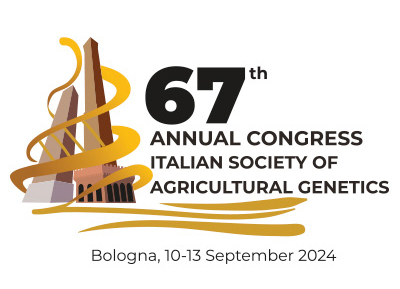LXVI SIGA Annual Congress
“Climate-smart plants to feed the future”
05-08 September 2023
SESSION 7 - Updates and upgrades in genome editing
ORAL COMMUNICATIONS| 7.01 | Expanding the genome editing toolbox by unlocking rna guided nucleases using massive metagenomic data |
| 7.02 | Genome editing for better, healthier tomatoes |
| 7.03 | Controls of stem elongation by the flowering pathway in rice |
| 7.04 | A new rice plant ideotype through genome editing: the SUSRICE project |
| 7.05 | New insights on the role of SlDMR6-1 in drought avoidance in tomato |
| 7.06 | Molecular and phenotypic characterization of potato plants edited in the mitochondrial genome by mitoTALEN and mitoTALECD approaches |
| 7.07 | Reduced susceptibility to downy mildew of DMR6 gene-edited grapevine plants and development of DNA-free edited mutants |
| 7.08 | Improving grape resilience to drought exploiting the CRISPR/Cas technology: functional characterization of the target gene through Spray Induced Gene Silencing (SIGS) |
| 7.09 | The florigen-activated gene OsMAIL1 determines stigma number in rice florets |
| 7.10 | A TRANSCRIPTION FACTOR COORDINATING FLOWERING AND STEM ELONGATION IN O. SATIVA |
| 7.11 | Editing of the durum wheat PDIL5-1 gene to increase resistance to soil-borne bymoviruses |
| 7.12 | The redundancy paradox: uncovering the mechanisms of paralogous compensation in the maize meristem |
| 7.13 | Genome editing in alfalfa by intron targeting using CRISPR-Cas9 |
| 7.14 | Evolution of tissue culture on Cannabis sativa through the use of assisted technologies: a promising approach for the development of agricultural biotechnologies |
| 7.15 | Genome-edited N. benthamiana plants accumulating zeaxanthin for the production of saffron crocins |
| 7.16 | Targeting tomato fruit allergens with CRISPR/Cas9 technology |
| 7.17 | Implementation of precision breeding strategies for male sterility induction in Solanaceae model species |
| 7.18 | Approaches to improve firmness in tomato landraces by genome editing |
| 7.19 | High pigment-2 CRISPR/Cas9 edited tomato lines obtained in different genetic backgrounds |
| 7.20 | Investigating the role of an ERF transcription factor in mediating stress response and tomato fruit ripening and quality |
| 7.21 | Vitamin D biofortification in Solanaceous species by using CRISPR/Cas9-mediated genome editing |
| 7.22 | Biofortification of tomato using genome editing |
| 7.23 | Stress tolerance in eggplant: can Downy mildew resistance 6 (DMR6) play a role? |
| 7.24 | Setting up of Virus-Induced Genome Editing (VIGE) protocol in eggplant |
| 7.25 | Unveiling the Role of CRISPR/Cas9-Generated MDHARs Mutants in Lactuca sativa |
| 7.26 | Comparative Analysis of Stable Genetic Transformation Methods for Knocking Out VviAGL11 in 'Microvine' Grapevine Cultivar |
| 7.27 | Application of CRISPR-cas9 system in grapevine (V. vinifera L.) and improvements in plant regeneration process |
| 7.28 | Plant regeneration from somatic embryogenesis and protoplast isolation of two Veneto region grapevine cultivars: Corvina Veronese and Garganega |
| 7.29 | Sustainable viticulture: different strategies to enhance the resistance of the vine to the main fungal diseases on Sicilian cultivars |
| 7.30 | Improve apple scab resistance via cisgenic approach |
| 7.31 | Advancements in the use of New Breeding Technologies to improve citrus fruit quality, reduce the flowering period and introduce the resistance to plant diseases |
